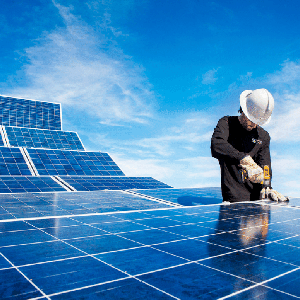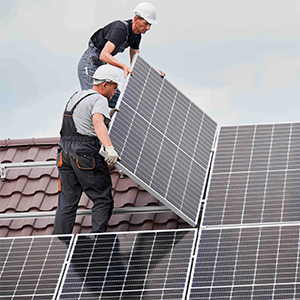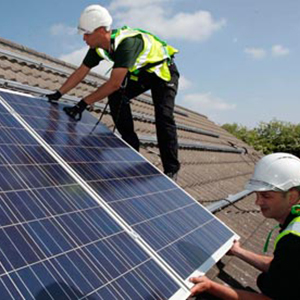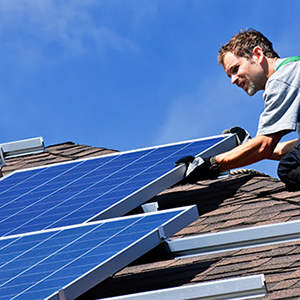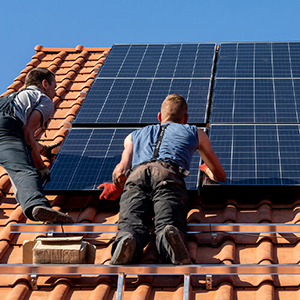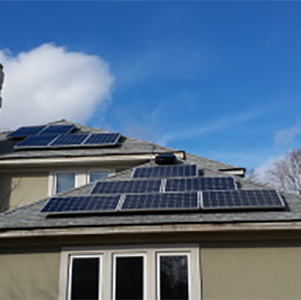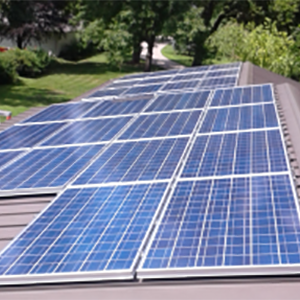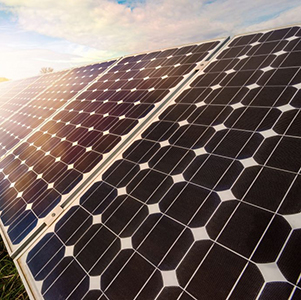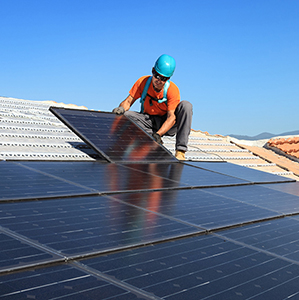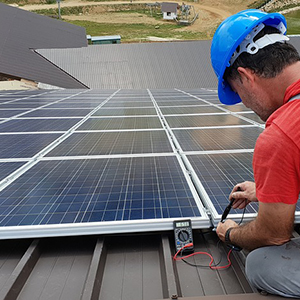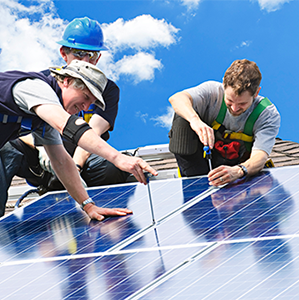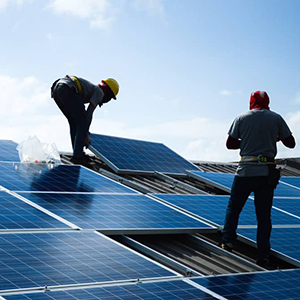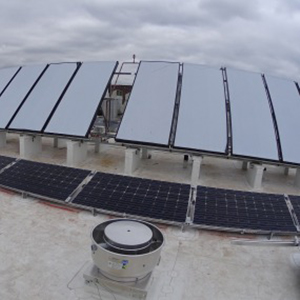The process for installing solar on your home or business can seem daunting, but below you’ll find a step-by-step guide full of tips on what to do. There are four main sections:
1. Site Assessment
2. Hiring a Contractor
3. Installation
4. Financing
1. Site Assessment
Before any installation can be made a site assessment must be completed. This site assessment will be performed by the solar installer prior to installation, but site assessments are also offered by trained, impartial third parties.
Things to consider prior to contacting installers:
• Does the roof of your house have good southern exposure?
• Western facing roofs typically offer sufficient exposure as well. Estimates show that western facing roofs can produce about 87% of the total energy generated by roofs with full southern exposure.
• Are there any trees, power lines, chimneys, neighbors property that shade your roof?
• Is your roof structurally sound?
• How old is your roof?
Solar Resource
Sunlight is the fuel for all solar technologies, and the term ‘solar resource’ refers to identifying how much of it is available to a given collector area. The most rudimentary analysis requires standing on your site with your arms up in a “Y” form and looking to see what obstructions there are in the field of vision between your arms. This basically represents the productive sun hours of 9am to 3pm.
There are professional devices, such as the Solar Pathfinder and Solmetric SunEye, that calculate the Total Solar Resource Fraction (TSRF) which accounts for shading, panel tilt and azimuth (direction relative to south).
The tilt of the earth on its axis and our location north of the equator result in a specific sun path that changes throughout the year. The sun is at its highest point at noon on the Summer Solstice, or June 21st.
Most photovoltaic and solar hot water systems are stationary, and having unobstructed solar access between the hours of 9AM and 3PM is ideal. Tracking systems usually follow the sun path from east to west during the day, and are seasonally adjusted for altitude angle.
Potential Installation Considerations
Flat panel collectors weigh about 200-250 lbs. Thermosyphon systems add the weight of the water storage tank. Residential scale evacuated tube arrays weigh about 175 lbs.
More serious considerations, from a structural perspective, are wind-induced loads and concentrated loads. Remember that the snow or ice that used to be spread out evenly over your roof will now be concentrated at the mounting feet. Most of us know what high heels do to a wood floor.
For these reasons, a structural analysis is often required by the building officials who review plans and issue permits for solar systems.
It is a good idea to install solar panels over a roof which has 15 of more years of life in it. Some folks do a partial re-roof under the area of the solar array even if they are not prepared to do a complete roof replacement.
Fire Marshalls are now asserting their authority in the permit/plan review process to make sure they have room to work in the event of a fire in the home/building. A qualified solar contractor will help you work through all of these issues; including working with a structural engineer if that becomes necessary.
With an increasing body of information available, the added assurance of a successful installation that these steps provide may add some expense but would be offset by avoiding potential future issues.
Process of Site Assessment
1. A Solar Site Assessment consists of several steps. Energy Use Inspection
• Methods of increasing the home or buildings energy efficiency are identified.
• Completion of an analysis of the building or home energy load.
2. Solar System Analysis
• Site assessment tools are used to determine available solar resource.
• The potential size of the solar array is determined.
• Locations for placement of the solar system are identified.
3. Cost
• The assessor will provide a cost estimate which is typically based on estimated energy production.
• The assessor will typically provide information on funding opportunities like grants/rebates/tax credits, and return on investment information.
Homeowner/Building Owner Site Assessment Tips
• It is important to consider cost but also keep in mind that the cheapest install may not always be the best.
• Have multiple parties complete site assessments to determine which installer fits the best with your goals.
• After receiving the site assessment, have multiple parties complete site visits to determine which installer best meets your goals.
• Some third party assessors may suggest installers, this suggestion may be beneficial but it is important to complete your own research on installers as well.
2. Hiring a Contractor
1. Find an Illinois certified contractor
• Look through the list of ISEA business members that are certified solar installers.
2. Verify certification
• In order to install solar within Illinois the contractor must be a Distributed Generation Certified Profession.
• For more information on certification qualifications, visit our Distributed Generation Installer Certification page.
3. Request information on prior work
• Many contractors will document prior work on their website. If they do not, then ask for this information.
• Determine the quantity of projects completed in Illinois.
4. Communicate with prior customers of the contractor
• If possible ask prior customers about there experience with the contractor.
• Talking with a customer who has a similar solar system as what has been proposed for your location can be beneficial.
5. Determine who is performing the work
• It is common for solar installers to subcontract out some or all of the installation. If this is the case verify the subcontractors certification and experience.
6. Determine the warranty coverage provided by the contractor
• Each contractor may provide different lengths of warranties for labor and parts included in the system.
7. Determine if the contractor completes the paperwork necessary to receive additional financial funding
• Some contractors will fill out the paperwork necessary to apply for financial bonuses such as tax breaks and rebates. Keep this in mind if this service is desired.
For more advice on How to Choose a Qualified Installer, view this page.
3. The Installation Process
Solar PV
• PV systems are typically mounted to a racking system facing as south as possible. South facing panels insure optimum electricity production in the north hemisphere.
• On a angled roof the racking system is mounted onto the roof.
• On a flat roof the racks are not mounted, but weighed down.
• Metallic coated wires are connected to transport the electricity generated by the panels to the inverter.
• The installer will then find a shaded area to mount the inverter to avoid overheating. The solar inverter changes the electricity created by the system into a more compatible format.
• A DC disconnect switch and utility meter will typically be close to the inverter.
• The output of the inverter and the solar system will be connected to the circuit breaker box.
• The house or building will draw electricity from the circuit breaker box.
• Any electricity not used by the residence or building will be sent to the local grid.
Solar Thermal
• Like PV systems, solar thermal systems mounted to face as south as possible.
• Pipes will be installed to transport the heated fluid from the solar collectors to the hot water storage tank.
• The hot water storage tank will typically be installed next to the hot water heater.
• Some building and homeowners may choose to replace their hot water heater with a tankless wall mounted system. This allows for installation of the hot water storage tank in the location of the old water heater.
• Safety features are installed into the system, these include an anti scald valve which mixes cold water into hot water, pressure and temperature release valves, and thermal expansion tanks.
For more information on Solar Thermal and Solar PV visit our How Solar Works page.
4. Financing
There are a variety of financial incentives for solar installation the United States Department of Energy has developed the Database of State Incentives for Renewables & Efficiency to keep track of these incentives.
Finance Tips
• Different types of solar systems will cost different amount. If your installer does not specify these differences make sure to ask about them.
• Costs of solar systems can be reduced with incentives, ask your installer about these incentives. Some installers may even fill out the incentive applications for you.
• Do not judge the cost of a solar system on upfront costs alone, ask your installer about the approximate payback period of the system.


